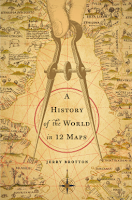Author: Jerry Brotton
Publication Information: Viking. 2013. 544 pages.
Book Source: I received this book as a publisher's galley through NetGalley free of cost in exchange for an honest review.
Favorite Quote: "They certainly will not show the world 'as it really is', because that cannot be represented. There is simply no such thing as an accurate map of the world, and there never will be. The paradox is that we can never know the world without a map, nor definitively represent it with one."
A History of the World in 12 Maps starts with Ptolemy's Geography dated from the second century and ends with the current version of Google Earth. The other maps included in the 12 are:
This book is dense. It contains a lot of information - on the maps themselves and on the geopolitical climate and events that led to the development of each map. As such, it becomes a history of cartography and a history of the world. At the same time, it is a very enjoyable and readable book. A great pick for anyone who enjoys history or geography.
A History of the World in 12 Maps starts with Ptolemy's Geography dated from the second century and ends with the current version of Google Earth. The other maps included in the 12 are:
- 1100s - the maps of Muhammad al-Idrisi created for the king of Sicily
- Circa 1300 - the Mappamundi created in Italy
- 1402 - Kangnido world map from Japan, one of the oldest surviving maps of East Asia
- 1507 - German cartographer Martin Waldseemuller's world map credited with the first usage of the word America
- 1529 - Diogo Ribeiro 1529 credited to be first scientific world map
- 1569 - Belgian Gerard Mercator's map that used a navigational grid
- 1600 - Joan Baleu's creation of an atlas in Amsterdam
- 1700s - Maps of France by the Cassini family, the first to use triangular measurements
- Early 1900s - maps by Halford Mackinder, the first to address geopolitical maps
- 1970s - Peters Projection named for German historian Arno Peters
This book is dense. It contains a lot of information - on the maps themselves and on the geopolitical climate and events that led to the development of each map. As such, it becomes a history of cartography and a history of the world. At the same time, it is a very enjoyable and readable book. A great pick for anyone who enjoys history or geography.

No comments:
Post a Comment